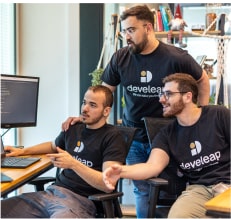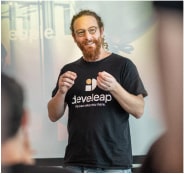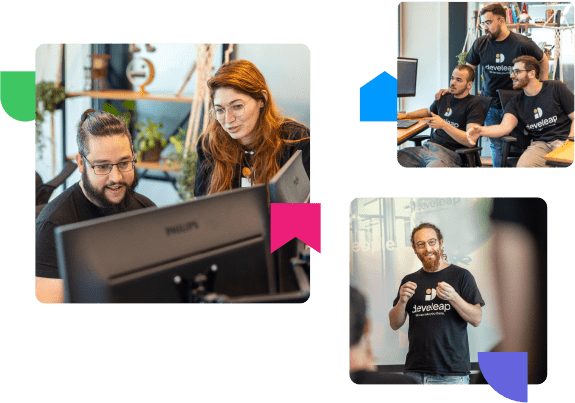We are the
DevOps you’ve
been looking for
From finding your correct architecture, adopting the right tools, and implementing the relevant development processes to make your tech team truly agile, we are the DevOps team you can trust.
Our customers are at the
heart of everything we do
Accelerate your DevOps flywheel
in 3 easy steps
1
Meet an expert
Book a call with our
DevOps expertDefine your specific
challenges
2
One size fits one
Fitting the right team for your company
Deep dive into your technical infrastructure and find the right solution that fits your company’s needs
3
Acceleration
We mesh the Develeap hive to your team
Locked value release, and potential acceleration starts
Some of the key services
we offer include
Reduce time to market up to 54%
Setting up CI/CD - on-prem, on cloud and even embedded
Reduce K8s cost as high as 73% ( 60% on average)
Moving to Kubernetes
Increase team productivity
Making the most out of your cloud - AWS, Azure, Google and Hybrid
Reducing defects across life cycle up to 30%
Tailoring SRE level observability
Are you ready to take your tech teams to greatness?
Check your DevOps team performance
Frequent delivery of functionality with higher quality
We focus on helping streamline your software development and deployment processes.
One size fits one
Our experts are constantly on the edge of knowledge and are trained and dedicated to finding and implementing the right solutions for your team.
No challenge is left unanswered
Our headquarters functions as a hive, constantly sharing knowledge and best practices to support your team.
Meet the people who’ll
take you there
Our team is always eager and ready to show you how DevOps can help your organization. Book a 30-minute online meeting with us to discuss your needs and see how we can partner with you to drive success.

Kobi Avshalom
DevOps

Roi Bandel
DevOps

Dori Kafri
Management

Ori Meyuhas
DevOps

Saar Cohen
Education

Maya Chernobroda
DevOps

Efi Shimon
DevOps

Oron Cohen
DevOps

Shay Levin
DevOps

Tzahi Grodzevsky
DevOps

Eilon Cohen
DevOps

Paul Miller
DevOps

Lina Yarovinsky
HR

Adir Sellam
DevOps

Elad Cirt
DevOps

Raviv Nadiv
DevOps

Aran Shavit
DevOps

Alex Kraportov
DevOps

Farid Manashirov
DevOps

Rotem Kalman
DevOps

Kfir Bekhavod
DevOps

Amir Benyamini
DevOps

Idan Korkidi
Education

Roy Zohar
DevOps

Amit Zarmon
Partnerships

Amir Shalem
DevOps

Inbal Drori
HR

Igor Rosenberg
DevOps

Gilad Neiger
DevOps

Amos Elitzur
DevOps

Kfir Bekhavod
DevOps

Shmuel Felman
DevOps

Eden Friedman
HR

Barel Elbaz
DevOps

Lejb Golovatyi
DevOps

Shem Tov Fisher
DevOps

Mickael Rahmime
DevOps

Baruch Bazak
DevOps

Leon Orlinski
DevOps

Tom Brovender
DevOps

Christina Babitski
DevOps

Boris Tsigelman
DevOps

Matan Shkalim
DevOps

Victor Romanov
DevOps

Alon Rosenwasser
DevOps

Dakar Tal
Education

Niv Yohanok
DevOps
What do our clients
think of us
Develeap people are motivated, energetic, self-learning DevOps Engineers.
At all times I have found them to be hard-working, serious, and professional. In addition to the strong people who work with us, they have the backs of strong technical people who can turn to them with any question. Develeap is definitely one of the strongest Devops people I have worked with.
Develeap team guided us through a complete revolution of our CI/CD and runtime environments. Together we completed successfully the docker/Kubernetes project and we're continuing adopting additional cutting-edge DevOps technologies.
Being the main decision-maker on R&D, and DevOps I was looking for a good development partner to work with. Someone who knew a lot, was flexible enough to accommodate my non-vanilla use-case and also not bother me with drawing Gantt charts. Develeap proved superb, highly knowledgeable and SUPER cooperative. We've implemented a very strong CI/CD cycle over simple yet bulletproof architecture. THANK YOU VERY MUCH DEVELEAP. I WILL contact you again!
One community.
Many great ideas for all.
Access to a wealth of resources
Get access to a centralized education center, where you can find information and resources to help you in your work.
Community support and collaboration
24/7 Real-time communication channel and collaboration among members, enabling you to quickly find solutions to challenges and get advice from experts.
Professional growth
Podcasts, videos, and expert tips, help you stay up-to-date on the latest DevOps trends and best practices, allowing you to continually grow your skills.
We're proud to partner with
industry leaders
Providing customers with unmatched scalability, security, and innovation in their software solutions
Join the Develeap community and stay up to date on the latest and greatest DevOps updates.
Join our mailing list!
Accelerate your DevOps expertise with our Education Center resources
The Develeap Education Center offers a wide range of resources and tools to enhance your DevOps skills, including podcasts, videos, and expert tips. Access everything you need to stay up-to-date with the latest trends and best practices in the industry.




















